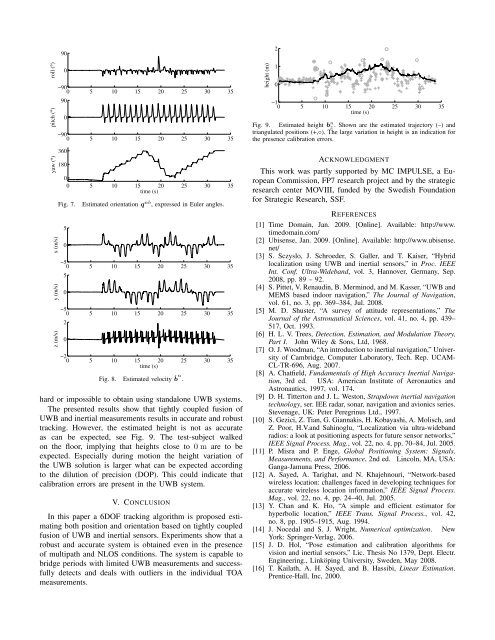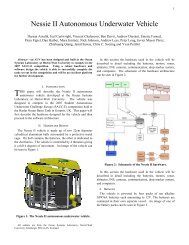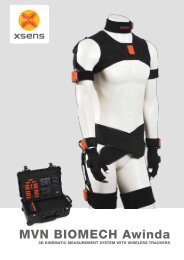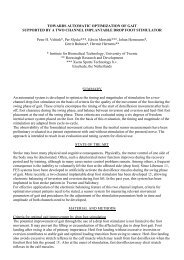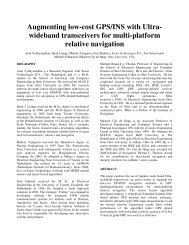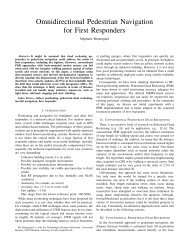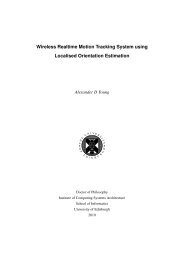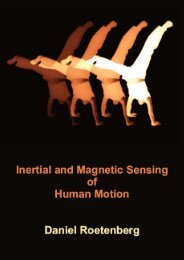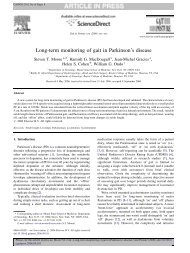Tightly Coupled UWB/IMU Pose Estimation - Xsens
Tightly Coupled UWB/IMU Pose Estimation - Xsens
Tightly Coupled UWB/IMU Pose Estimation - Xsens
- No tags were found...
Create successful ePaper yourself
Turn your PDF publications into a flip-book with our unique Google optimized e-Paper software.
oll (°)pitch (°)yaw (°)x (m/s)y (m/s)z (m/s)900−900 5 10 15 20 25 30 35900−900 5 10 15 20 25 30 3536018000 5 10 15 20 25 30 35time (s)Fig. 7.50Estimated orientation q nb , expressed in Euler angles.−50 5 10 15 20 25 30 3550−50 5 10 15 20 25 30 3520−20 5 10 15 20 25 30 35time (s)Fig. 8. Estimated velocity ḃn .hard or impossible to obtain using standalone <strong>UWB</strong> systems.The presented results show that tightly coupled fusion of<strong>UWB</strong> and inertial measurements results in accurate and robusttracking. However, the estimated height is not as accurateas can be expected, see Fig. 9. The test-subject walkedon the floor, implying that heights close to 0 m are to beexpected. Especially during motion the height variation ofthe <strong>UWB</strong> solution is larger what can be expected accordingto the dilution of precision (DOP). This could indicate thatcalibration errors are present in the <strong>UWB</strong> system.V. CONCLUSIONIn this paper a 6DOF tracking algorithm is proposed estimatingboth position and orientation based on tightly coupledfusion of <strong>UWB</strong> and inertial sensors. Experiments show that arobust and accurate system is obtained even in the presenceof multipath and NLOS conditions. The system is capable tobridge periods with limited <strong>UWB</strong> measurements and successfullydetects and deals with outliers in the individual TOAmeasurements.height (m)210−10 5 10 15 20 25 30 35time (s)Fig. 9. Estimated height b n z . Shown are the estimated trajectory (–) andtriangulated positions (+,◦). The large variation in height is an indication forthe presence calibration errors.ACKNOWLEDGMENTThis work was partly supported by MC IMPULSE, a EuropeanCommission, FP7 research project and by the strategicresearch center MOVIII, funded by the Swedish Foundationfor Strategic Research, SSF.REFERENCES[1] Time Domain, Jan. 2009. [Online]. Available: http://www.timedomain.com/[2] Ubisense, Jan. 2009. [Online]. Available: http://www.ubisense.net/[3] S. Sczyslo, J. Schroeder, S. Galler, and T. Kaiser, “Hybridlocalization using <strong>UWB</strong> and inertial sensors,” in Proc. IEEEInt. Conf. Ultra-Wideband, vol. 3, Hannover, Germany, Sep.2008, pp. 89 – 92.[4] S. Pittet, V. Renaudin, B. Merminod, and M. Kasser, “<strong>UWB</strong> andMEMS based indoor navigation,” The Journal of Navigation,vol. 61, no. 3, pp. 369–384, Jul. 2008.[5] M. D. Shuster, “A survey of attitude representations,” TheJournal of the Astronautical Sciences, vol. 41, no. 4, pp. 439–517, Oct. 1993.[6] H. L. V. Trees, Detection, <strong>Estimation</strong>, and Modulation Theory,Part I. John Wiley & Sons, Ltd, 1968.[7] O. J. Woodman, “An introduction to inertial navigation,” Universityof Cambridge, Computer Laboratory, Tech. Rep. UCAM-CL-TR-696, Aug. 2007.[8] A. Chatfield, Fundamentals of High Accuracy Inertial Navigation,3rd ed. USA: American Institute of Aeronautics andAstronautics, 1997, vol. 174.[9] D. H. Titterton and J. L. Weston, Strapdown inertial navigationtechnology, ser. IEE radar, sonar, navigation and avionics series.Stevenage, UK: Peter Peregrinus Ltd., 1997.[10] S. Gezici, Z. Tian, G. Giannakis, H. Kobayashi, A. Molisch, andZ. Poor, H.V.and Sahinoglu, “Localization via ultra-widebandradios: a look at positioning aspects for future sensor networks,”IEEE Signal Process. Mag., vol. 22, no. 4, pp. 70–84, Jul. 2005.[11] P. Misra and P. Enge, Global Positioning System: Signals,Measurements, and Performance, 2nd ed. Lincoln, MA, USA:Ganga-Jamuna Press, 2006.[12] A. Sayed, A. Tarighat, and N. Khajehnouri, “Network-basedwireless location: challenges faced in developing techniques foraccurate wireless location information,” IEEE Signal Process.Mag., vol. 22, no. 4, pp. 24–40, Jul. 2005.[13] Y. Chan and K. Ho, “A simple and efficient estimator forhyperbolic location,” IEEE Trans. Signal Process., vol. 42,no. 8, pp. 1905–1915, Aug. 1994.[14] J. Nocedal and S. J. Wright, Numerical optimization. NewYork: Springer-Verlag, 2006.[15] J. D. Hol, “<strong>Pose</strong> estimation and calibration algorithms forvision and inertial sensors,” Lic. Thesis No 1379, Dept. Electr.Engineering., Linköping University, Sweden, May 2008.[16] T. Kailath, A. H. Sayed, and B. Hassibi, Linear <strong>Estimation</strong>.Prentice-Hall, Inc, 2000.


